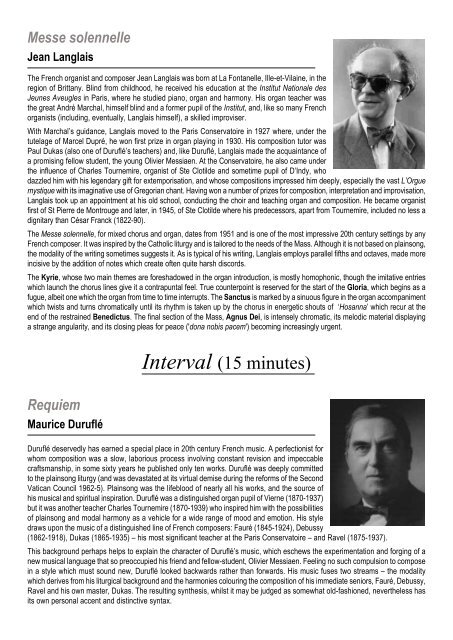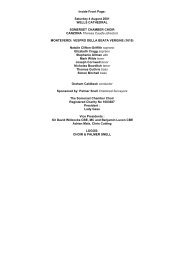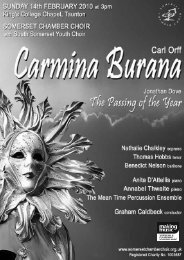Click here to view the concert programme - Somerset Chamber Choir
Click here to view the concert programme - Somerset Chamber Choir
Click here to view the concert programme - Somerset Chamber Choir
You also want an ePaper? Increase the reach of your titles
YUMPU automatically turns print PDFs into web optimized ePapers that Google loves.
Messe solennelle<br />
Jean Langlais<br />
The French organist and composer Jean Langlais was born at La Fontanelle, Ille-et-Vilaine, in <strong>the</strong><br />
region of Brittany. Blind from childhood, he received his education at <strong>the</strong> Institut Nationale des<br />
Jeunes Aveugles in Paris, w<strong>here</strong> he studied piano, organ and harmony. His organ teacher was<br />
<strong>the</strong> great André Marchal, himself blind and a former pupil of <strong>the</strong> Institut, and, like so many French<br />
organists (including, eventually, Langlais himself), a skilled improviser.<br />
With Marchal’s guidance, Langlais moved <strong>to</strong> <strong>the</strong> Paris Conserva<strong>to</strong>ire in 1927 w<strong>here</strong>, under <strong>the</strong><br />
tutelage of Marcel Dupré, he won first prize in organ playing in 1930. His composition tu<strong>to</strong>r was<br />
Paul Dukas (also one of Duruflé’s teachers) and, like Duruflé, Langlais made <strong>the</strong> acquaintance of<br />
a promising fellow student, <strong>the</strong> young Olivier Messiaen. At <strong>the</strong> Conserva<strong>to</strong>ire, he also came under<br />
<strong>the</strong> influence of Charles Tournemire, organist of Ste Clotilde and sometime pupil of D’Indy, who<br />
dazzled him with his legendary gift for extemporisation, and whose compositions impressed him deeply, especially <strong>the</strong> vast L’Orgue<br />
mystique with its imaginative use of Gregorian chant. Having won a number of prizes for composition, interpretation and improvisation,<br />
Langlais <strong>to</strong>ok up an appointment at his old school, conducting <strong>the</strong> choir and teaching organ and composition. He became organist<br />
first of St Pierre de Montrouge and later, in 1945, of Ste Clotilde w<strong>here</strong> his predecessors, apart from Tournemire, included no less a<br />
dignitary than César Franck (1822-90).<br />
The Messe solennelle, for mixed chorus and organ, dates from 1951 and is one of <strong>the</strong> most impressive 20th century settings by any<br />
French composer. It was inspired by <strong>the</strong> Catholic liturgy and is tailored <strong>to</strong> <strong>the</strong> needs of <strong>the</strong> Mass. Although it is not based on plainsong,<br />
<strong>the</strong> modality of <strong>the</strong> writing sometimes suggests it. As is typical of his writing, Langlais employs parallel fifths and octaves, made more<br />
incisive by <strong>the</strong> addition of notes which create often quite harsh discords.<br />
The Kyrie, whose two main <strong>the</strong>mes are foreshadowed in <strong>the</strong> organ introduction, is mostly homophonic, though <strong>the</strong> imitative entries<br />
which launch <strong>the</strong> chorus lines give it a contrapuntal feel. True counterpoint is reserved for <strong>the</strong> start of <strong>the</strong> Gloria, which begins as a<br />
fugue, albeit one which <strong>the</strong> organ from time <strong>to</strong> time interrupts. The Sanctus is marked by a sinuous figure in <strong>the</strong> organ accompaniment<br />
which twists and turns chromatically until its rhythm is taken up by <strong>the</strong> chorus in energetic shouts of ‘Hosanna’ which recur at <strong>the</strong><br />
end of <strong>the</strong> restrained Benedictus. The final section of <strong>the</strong> Mass, Agnus Dei, is intensely chromatic, its melodic material displaying<br />
a strange angularity, and its closing pleas for peace ('dona nobis pacem') becoming increasingly urgent.<br />
Interval (15 minutes)<br />
Requiem<br />
Maurice Duruflé<br />
Duruflé deservedly has earned a special place in 20th century French music. A perfectionist for<br />
whom composition was a slow, laborious process involving constant revision and impeccable<br />
craftsmanship, in some sixty years he published only ten works. Duruflé was deeply committed<br />
<strong>to</strong> <strong>the</strong> plainsong liturgy (and was devastated at its virtual demise during <strong>the</strong> reforms of <strong>the</strong> Second<br />
Vatican Council 1962-5). Plainsong was <strong>the</strong> lifeblood of nearly all his works, and <strong>the</strong> source of<br />
his musical and spiritual inspiration. Duruflé was a distinguished organ pupil of Vierne (1870-1937)<br />
but it was ano<strong>the</strong>r teacher Charles Tournemire (1870-1939) who inspired him with <strong>the</strong> possibilities<br />
of plainsong and modal harmony as a vehicle for a wide range of mood and emotion. His style<br />
draws upon <strong>the</strong> music of a distinguished line of French composers: Fauré (1845-1924), Debussy<br />
(1862-1918), Dukas (1865-1935) – his most significant teacher at <strong>the</strong> Paris Conserva<strong>to</strong>ire – and Ravel (1875-1937).<br />
This background perhaps helps <strong>to</strong> explain <strong>the</strong> character of Duruflé’s music, which eschews <strong>the</strong> experimentation and forging of a<br />
new musical language that so preoccupied his friend and fellow-student, Olivier Messiaen. Feeling no such compulsion <strong>to</strong> compose<br />
in a style which must sound new, Duruflé looked backwards ra<strong>the</strong>r than forwards. His music fuses two streams – <strong>the</strong> modality<br />
which derives from his liturgical background and <strong>the</strong> harmonies colouring <strong>the</strong> composition of his immediate seniors, Fauré, Debussy,<br />
Ravel and his own master, Dukas. The resulting syn<strong>the</strong>sis, whilst it may be judged as somewhat old-fashioned, never<strong>the</strong>less has<br />
its own personal accent and distinctive syntax.












